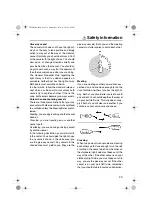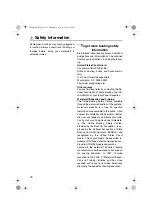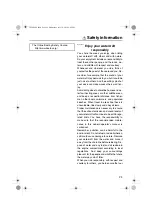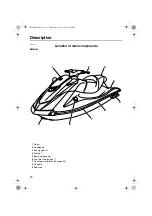
Safety information
20
Give-way vessel
The vessel which does not have the right-of-
way has the duty to take positive and timely
action to stay out of the way of the stand-on
vessel. Normally, you should not cross in front
of the vessel with the right-of-way. You should
slow down or change directions briefly and
pass behind the other vessel. You should al-
ways move in such a way that the operator of
the other vessel can see what you are doing.
The General Prudential Rule regarding the
right-of-way is that if a collision appears un-
avoidable, neither boat has the right-of-way.
Both boats must avoid the collision.
In other words, follow the standard rules ex-
cept when a collision will occur unless both
vessels try to avoid each other. If that is the
case, both vessels become give-way vessels.
Rules when encountering vessels
There are three main situations that you may
encounter with other vessels which could lead
to a collision unless the Steering Rules are fol-
lowed:
Meeting: you are approaching another vessel
head-on
Crossing: you are traveling across another
vessel’s path
Overtaking: you are passing or being passed
by another vessel
In the following illustration, your watercraft is
in the center. You should give the right-of-way
to any vessels shown in the white area (you
are the give-way vessel). Any vessels in the
shaded area must yield to you (they are the
give-way vessels). Both you and the meeting
vessel must alter course to avoid each other.
Meeting
If you are meeting another power-driven ves-
sel head on, and are close enough to run the
risk of collision, neither of you has the right-of-
way. Both of you should alter course to avoid
an accident. You should keep the other vessel
on your port (left) side. This rule does not ap-
ply if both of you will clear one another if you
continue on your set course and speed.
Crossing
When two power-driven vessels are crossing
each other’s path close enough to run the risk
of collision, the vessel which has the other on
the starboard (right) side must keep out of the
way of the other. If the other vessel is on your
starboard (right) side, you must keep out of its
way; you are the give-way vessel. If the other
vessel is on your port (left) side, remember
that you should maintain course and direction,
UF2M10E0.book Page 20 Wednesday, July 14, 2010 5:02 PM
Содержание VXS: VXR
Страница 12: ...General and important labels 7 UF2M10E0 book Page 7 Wednesday July 14 2010 5 02 PM ...
Страница 13: ...General and important labels 8 EJU35925 Other labels UF2M10E0 book Page 8 Wednesday July 14 2010 5 02 PM ...
Страница 107: ...UF2M10E0 book Page 3 Wednesday July 14 2010 5 02 PM ...
Страница 108: ...Printed in USA July 2010 0 2 1 CR YAMAHA MOTOR CORPORATION USA DIC183 ...
















































